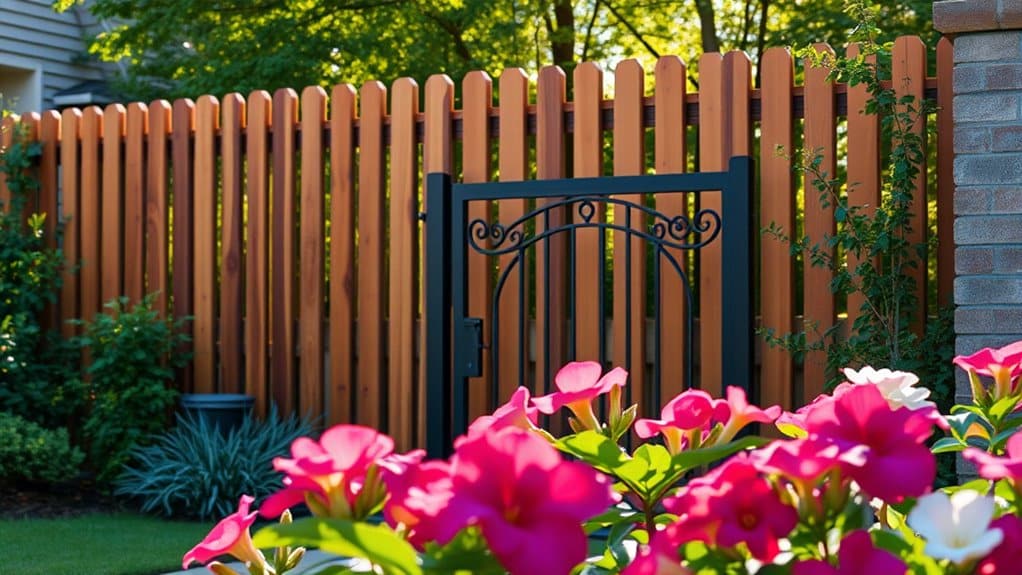To enhance your residential fencing with lighting, start by identifying your purpose—whether for safety or ambiance. Choose between solar lights for easy installation or wired options for more control. Place lights strategically along pathways and highlights to create inviting glows. For best results, mix ambient and functional lighting. Regular upkeep ensures optimal performance. With thoughtful planning, your fence can become a beautiful feature that shines at night.
Key Takeaways
- Decide between solar or wired lights based on how bright you want them and how much upkeep you’re willing to do.
- Use a blend of soft ambient lights and brighter functional ones to create a warm vibe while keeping pathways safe.
- Place lights to accentuate your fence’s features and cast cool shadows for a more appealing look.
- Keep your lights in good shape by cleaning them, checking for any wiring issues, and trimming back nearby plants.
- Think about adding smart lighting for easy remote control and better security around your fence.
Determining the Purpose of Your Fence Lighting
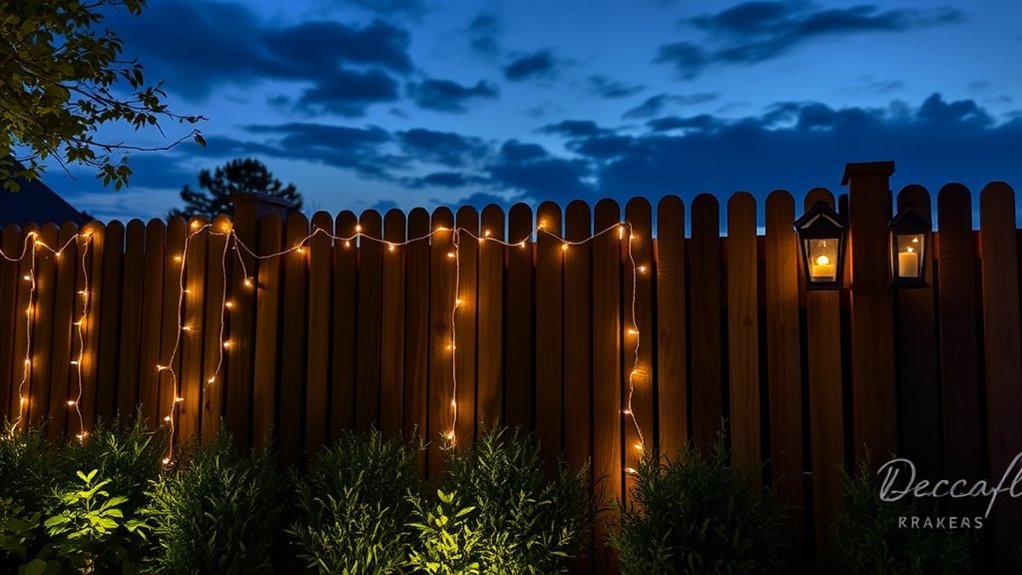
Before adding lighting to your fence, it’s important to decide its purpose. Are you looking to enhance the look of your yard or improve safety?
For curb appeal, lights can showcase your fence and create a cozy atmosphere for outdoor gatherings. If safety is your main concern, brightening pathways can help prevent trips and highlight any obstacles at night. A well-lit fence not only keeps your property secure by deterring intruders but also makes your space more inviting for family and friends. Knowing your goals will help you choose the right lighting that balances beauty and safety. Additionally, incorporating outdoor fence lighting can significantly enhance the aesthetic appeal of your outdoor space, creating depth and dimension.
Choosing the Right Lighting Types and Styles
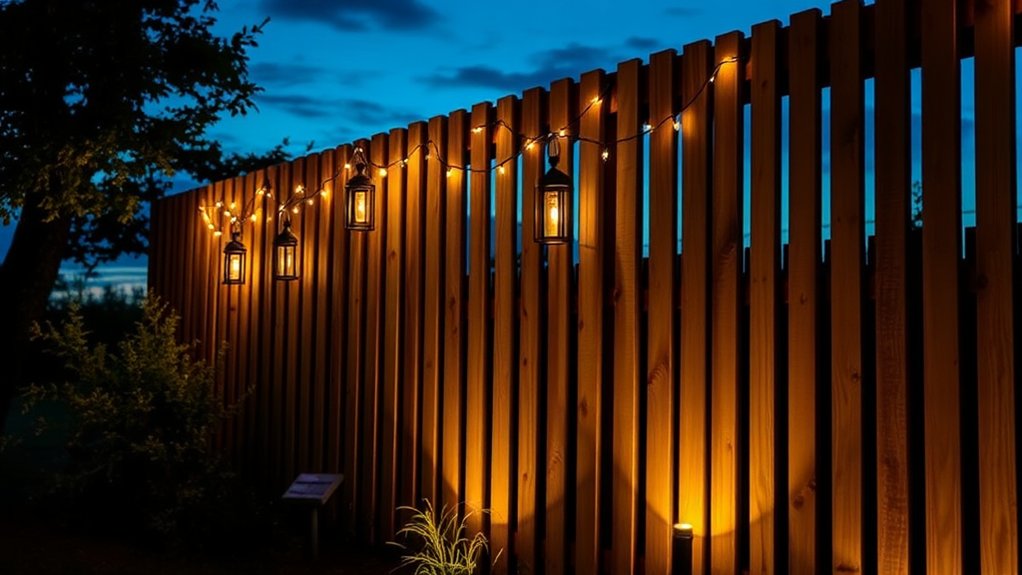
When choosing fence lighting, you have two main options: solar lights and wired lights. Solar lights are eco-friendly and easy to install, making them great for a low-maintenance setup. Energy-efficient lighting options like LED bulbs can make solar lights even more appealing. Wired lights offer consistent brightness and reliability, ideal for functional purposes. Think about the atmosphere you want—do you prefer a cozy, warm glow or bright, practical lighting?
Solar vs. Wired Options
Deciding between solar and wired lighting for your residential fencing? Here’s a quick breakdown:
Solar Lighting:
- Pros: Budget-friendly, easy to install (no professional help needed), and powered by renewable energy, which saves you money and reduces your carbon footprint. Additionally, solar lights are easy to install, making them a great weekend DIY project.
- Cons: Brightness and duration can decrease on cloudy days, and customization options are usually limited.
Wired Lighting:
- Pros: Offers consistent performance and more control over aesthetics.
- Cons: Higher installation costs and more energy consumption.
Consider your budget, desired ambiance, and environmental priorities to find the right lighting solution for your home.
Ambient vs. Functional Lighting
When choosing lighting for your residential fencing, it’s essential to understand the roles of ambient and functional lighting.
Ambient lighting provides a warm glow, ideal for creating a cozy atmosphere during gatherings or relaxing evenings. For example, string lights can be draped over hedges to add charm.
Functional lighting, however, focuses on safety and security. Pathway lights guide you along walkways, and downlights mimic moonlight to help deter intruders.
By combining both types of lighting, you can create an appealing outdoor space that’s both inviting and secure.
Consider your personal style and needs to design a welcoming environment.
Color Temperature Selection
The right color temperature can change your outdoor space’s vibe. For cozy evenings, choose warm whites below 3000K to create a soft glow around your fence, ideal for relaxation.
To enhance your garden’s beauty, go for medium temperatures between 3000K and 3500K, which bring out greens and add clarity.
If security is your priority, cool temperatures above 4000K can help, but they may feel harsh.
Match your lighting to your fence style and surroundings to create a harmonious and inviting atmosphere.
Preparing for Installation
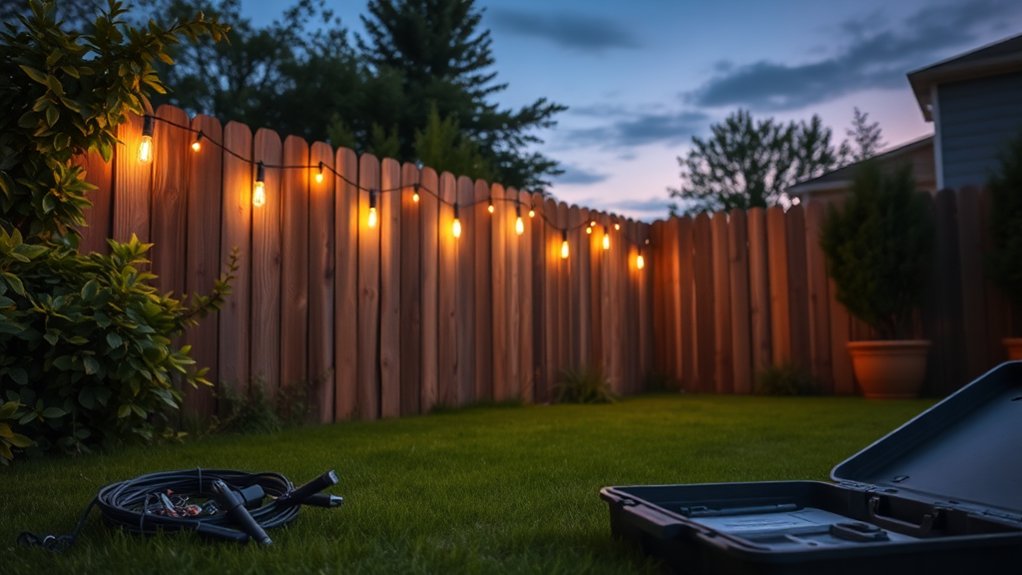
Before transforming your fence with lighting, assess your needs and plan the layout.
Consider how each light type—like cozy string lights or bold spotlights—will enhance your space. A solid plan will ensure a smooth installation and help bring your vision to life.
Assess Lighting Needs
To ensure your outdoor space is functional and inviting, start by assessing your lighting needs.
Examine the layout of your yard—consider slopes, obstacles, and plants, as they impact where and how much light you need. Identify key areas for safety, like pathways and property edges, and take note of shaded spots and areas that get sunlight.
Decide how long you want your lights on each night; this will help you choose between solar lights for sunny areas or wired options for consistent brightness. Additionally, consider environmental factors that may influence the performance and visibility of your lighting features.
Choose Light Type
When illuminating your residential fencing, it’s essential to choose the right light type that meets your style and needs. Here’s a quick look at popular options:
| Light Type | Benefits |
|---|---|
| Solar Lights | No wiring, cost-effective |
| String Lights | Fun, easy installation |
| Recessed Fence Lights | Modern, sleek look |
| LED Lights | Long-lasting, low maintenance |
Solar lights save on electricity costs, while string lights add a festive touch. Recessed lights suit minimalistic designs, and LEDs are highly efficient. Choose the option that best reflects your taste and creates the right evening atmosphere!
Plan Installation Layout
Planning your lighting installation is crucial for bringing your vision to life. Start by checking your fence’s condition and measuring its length to figure out how many lights you need.
Look for nearby electrical sources, or consider solar lights as an alternative. Mark where you’ll install the lights for even spacing, and sketch your yard to visualize the layout.
Think about your lighting goals—whether for ambiance, security, or both—while considering obstacles like trees or garden features. Aim for balanced lighting to avoid dark spots and create a warm glow.
Lastly, check local regulations to ensure compliance with neighborhood standards. Happy planning!
Safety and Electrical Considerations
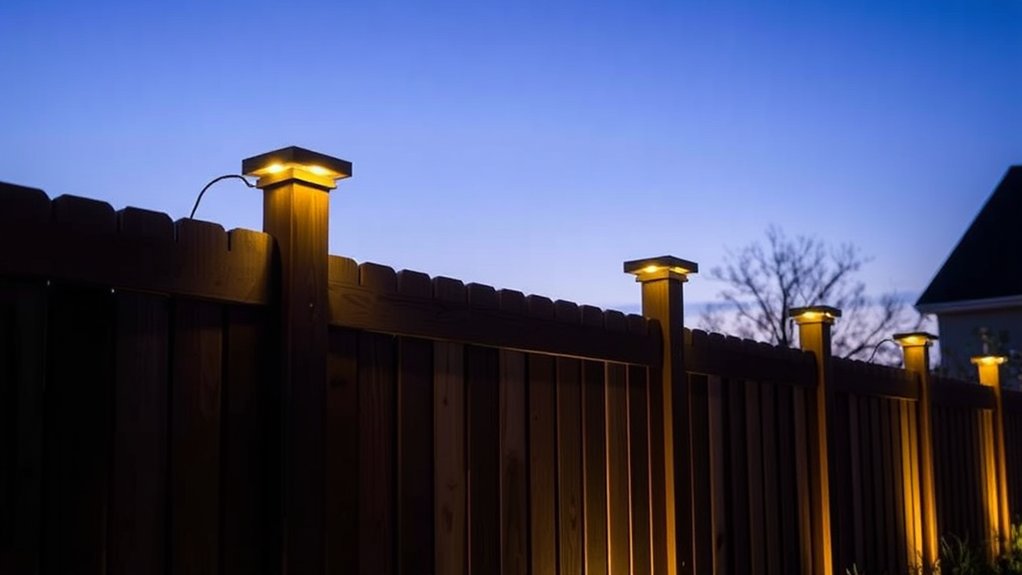
Adding lighting to your residential fencing can improve security and appearance, but safety should come first.
Make sure your setup complies with local electrical codes to avoid legal issues. It’s best to hire professionals for the installation and choose low-voltage systems for added safety.
Use sealed fixtures to protect against moisture and install GFCI-protected outlets to prevent electrical shocks.
Regularly check your wiring and clean fixtures to reduce fire risks. Always unplug the lights before changing bulbs.
Strategic Placement for Maximum Impact
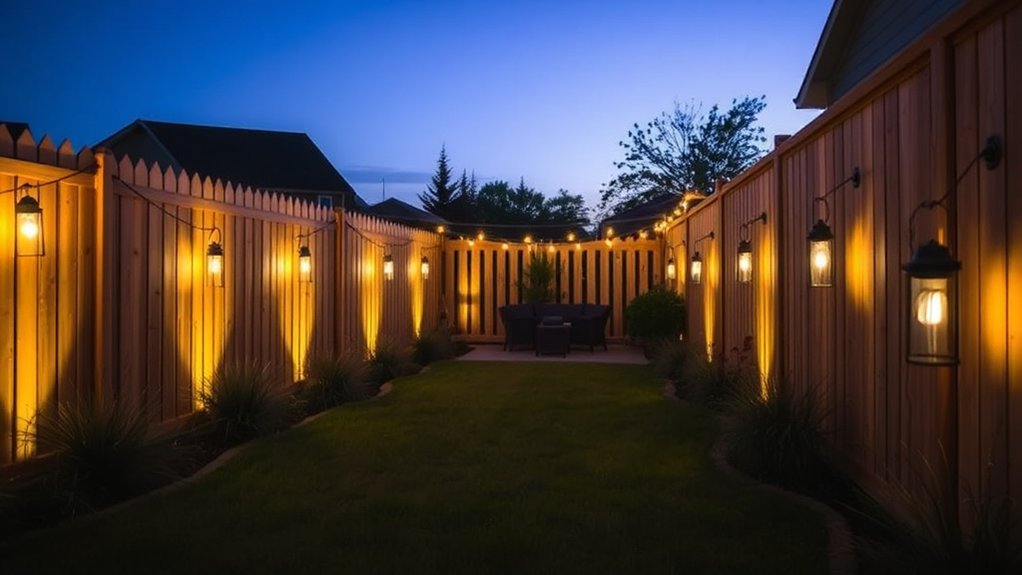
To create a striking visual effect with your fence lighting, consider the placement of your lights carefully. Space them every second or third post for a warm glow that enhances your outdoor area without being overpowering.
Ensure the number of lights matches your fence’s style and the surrounding landscape. For rustic wood fences, choose soft lantern-style lights, while sleek in-fence LEDs work well for modern designs.
Warm lights create a cozy feel, while cool white lights add a contemporary vibe. Check the layout at night to emphasize key features and achieve a layered look that enhances your fence’s aesthetic.
Maintaining Your Fence Lighting

To keep your fence lighting bright and functional, follow these three simple maintenance steps:
- Trim Vegetation: Regularly cut back plants or trees that might block or harm your lights.
- Remove Debris: Clear leaves, grass, and mulch from around the fixtures to ensure they shine effectively.
- Inspect Wires: Check for any frayed or damaged wiring to keep everything safe and extend the life of your lights.
Enhancing Aesthetics With Creative Lighting Techniques

Enhancing your fencing with creative lighting can significantly boost its visual appeal and create a captivating outdoor atmosphere.
Use a layered lighting approach, combining uplights and string lights to add depth. Highlight unique features like decorative panels and use strategic placement for interesting shadow effects.
For a modern touch, consider sleek recessed lights or playful fairy lights for gatherings. Adjustable fixtures allow you to focus light where it’s needed most.
Opt for energy-efficient options, like solar-powered lights, to keep your space bright and eco-friendly. Incorporating smart technology into your lighting can also enhance security and surveillance capabilities.
Frequently Asked Questions
How Do I Choose the Best Color Temperature for My Lights?
When choosing color temperature, think about the mood you want to create. Warm tones (2700K-3000K) are great for cozy spaces, ideal for relaxing evenings. Cooler tones boost energy and detail, making them perfect for work areas or active rooms. Choose wisely to match your desired atmosphere!
Can I Mix Different Types of Lighting for My Fence?
Yes, you can mix different types of fence lighting! For example, using spotlights for focused illumination alongside string lights for a cozy atmosphere can enhance your outdoor space. This combination not only improves aesthetics but also boosts safety and functionality.
What Is the Average Lifespan of Solar Lights?
The average lifespan of solar lights ranges from 1 to 20 years, depending on their quality and how well you maintain them. Regular cleaning and inspections can help ensure they last longer and shine brightly.
How Do Weather Conditions Affect Outdoor Lighting?
Weather conditions significantly affect outdoor lighting durability. It’s essential to select fixtures that can handle rain, wind, and extreme temperatures. For instance, lights designed for wet conditions can resist moisture, while sturdy designs prevent damage from strong winds. This ensures your outdoor lighting remains functional and efficient, no matter the season.
Are There Any Specific Regulations for Outdoor Lighting?
Outdoor lighting regulations can be tricky to navigate. Generally, they require fixtures to be shielded to prevent light from spilling into unwanted areas, like neighbors’ yards. Additionally, there are often height restrictions to keep lights from shining directly into homes or streets. For instance, a common rule is to keep residential lights below a certain height, usually around 15 feet, to reduce light trespass. Following these guidelines ensures a well-lit space without disturbing the surrounding environment.
Conclusion
Adding lighting to your residential fencing enhances evening ambiance and increases curb appeal. Well-lit outdoor spaces can raise your home’s value by 20%. With strategic placement and style, your fence can become a striking feature at night. Be creative, follow safety guidelines, and transform your outdoor area into a cozy retreat under the stars.




